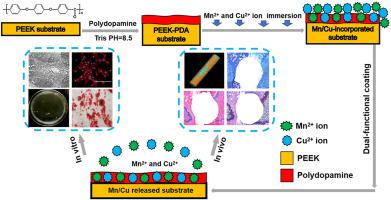Materials Today Advances ( IF 8.1 ) Pub Date : 2021-09-03 , DOI: 10.1016/j.mtadv.2021.100162 Lei Wang 1 , Huazheng He 1 , Xing Yang 2 , Yinchang Zhang 1 , Shouliang Xiong 1 , Chao Wang 1 , Xin Yang 1 , Bo Chen 3 , Qiang Wang 1

|
After the surgical implantation of polyetheretherketone (PEEK) orthopedic biomaterials, there are two major clinical challenges, implantation-related pathogen infection and poor osseointegration-caused aseptic loosening, threaten the lifespan and the success of the implants. In this study, we developed PEEK implants with antibacterial and osteogenesis capabilities by the bimetallic ions immersion method. Specifically, we pre-treated the PEEK implants with polydopamine (PDA) and then immobilized it (PEEK-PDA) with Mn2+ and Cu 2+ to obtain the bimetallic ions-modified PEEK denoted as PEEK-PDA-Mn/Cu. The PEEK-PDA-Mn/Cu exhibited enhanced antibacterial capabilities in both Staphylococcus aureus (S. aureus) and Escherichia coli (E. coli) compared with PEEK without the modification of Cu 2+. In addition, MC3T3-E1 cells showed better morphology and enhanced osteogenic differentiation with the treatment of PEEK-PDA-Mn/Cu than other PEEK implants. Furthermore, S. aureus-infected femur-defect Sprague-Dawley rat models were developed to evaluate the function of PEEK-PDA-Mn/Cu in vivo. After 2 and 4 weeks of implantations, rats treated with PEEK-PDA-Mn/Cu exhibited limited bacterial infections and enhanced new bone formation compared with the rats treated with other PEEK implants. Overall, the PEEK-PDA-Mn/Cu can inhibit bacterial infections and promote osteogenic differentiation both in vitro and in vivo, which could provide a promising PEEK candidate for clinical applications.
中文翻译:

双金属离子调节骨植入的 PEEK 具有抗菌和成骨活性
聚醚醚酮(PEEK)骨科生物材料手术植入后,存在两大临床挑战,植入相关病原体感染和骨整合不良引起的无菌性松动,威胁着植入物的寿命和成功。在这项研究中,我们通过双金属离子浸渍法开发了具有抗菌和成骨能力的 PEEK 植入物。具体来说,我们用聚多巴胺 (PDA) 预处理 PEEK 植入物,然后用 Mn 2+和 Cu 2+将其固定 (PEEK-PDA)以获得双金属离子修饰的 PEEK,表示为 PEEK-PDA-Mn/Cu。PEEK-PDA-Mn/Cu 在金黄色葡萄球菌( S. aureus ) 和大肠杆菌( E.coli ) 与未修饰 Cu 2+ 的PEEK 相比。此外,与其他 PEEK 植入物相比,MC3T3-E1 细胞在 PEEK-PDA-Mn/Cu 处理下表现出更好的形态和增强的成骨分化。此外,还开发了金黄色葡萄球菌感染的股骨缺陷 Sprague-Dawley 大鼠模型,以评估 PEEK-PDA-Mn/Cu在体内的功能。植入 2 周和 4 周后,与用其他 PEEK 植入物治疗的大鼠相比,用 PEEK-PDA-Mn/Cu 治疗的大鼠表现出有限的细菌感染和增强的新骨形成。总体而言,PEEK-PDA-Mn/Cu 可以在体外和体外抑制细菌感染并促进成骨分化。体内,这可以为临床应用提供有希望的 PEEK 候选者。











































 京公网安备 11010802027423号
京公网安备 11010802027423号